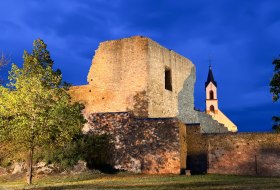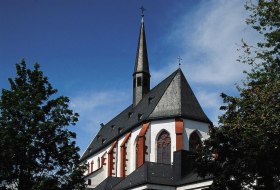
searchMenu


Directly opposite the train stop in Bingen-Gaulsheim, the innovative wooden building is located in the middle of the nature experience area AuenLand. The center is the basis for the diverse work of the full-time and voluntary nature conservationists. Here you can find inspiration to become active in nature conservation yourself: At home or in the numerous projects at NABU! Nature conservation at home Wild herb areas, greening of parking lots and near-natural green roofs are just a few examples of how you can bring more nature into your…

Epitaph at Windhäuser Hof by Jeanbon Saint-André on the occasion of the 200th anniversary of his death in 2013 From 1801 Jeanbon Saint-André was General Commissioner under Napoleon Bonaparte of the four departments on the left bank of the Rhine that were established in 1798. From February 1802 he was French prefect of the Département du Mont-Tonnerre based in Mainz. In 1809 he acquired the Windhäuser Hof as a summer residence.

The love nest Built by Daniel Graf from Monzernheim in 1934. It is a brick building with a concrete flat roof and a quarry stone foundation. Inside, a small bench was placed all around. The eastern wall clearly proves that it was and still is a favorite shelter for lovers. Height: 182 District: "In the middle valley" called "Hasenloch" History / Stories / Anecdotes: The current owner is the winery Keller / Flörsheim-Dalsheim (since 2014). Previously, it belonged to the winery Mayer from Ober…

The vineyard house "Perka" is an experimental and research building of the Technical University of Kaiserslautern and consists of high-strength concrete. It was built in cooperation between the Faculty of Architecture and the Faculty of Civil Engineering to test design and construction strategies with ultra-high strength concrete. The design is by Christoph Perka, who also gave the building its name.

The church is elevated and was once surrounded by a defensive wall and a ring of elm trees (Effenring), as is often the case in Rheinhessen. The stocky small choir in the tower and the sacristy attached to the east were provided with a net vault in 1494, according to a record of a console stone of the sacristy. In the reveal of the eastern window of the choir, a well-preserved late Gothic mural painting (St. Cyriacus or Laurentius and St. Erasmus) can be admired. Liebfrauenland - Gothic in Rheinhessen Translated with www.DeepL.com/Translator…

The castle Neu Baumburg, also called Neu-Bamberg, Neubamberg, is the ruin of an elevated castle above the community Neu-Bamberg. It was built around 1253 by the Raugrafen, mentioned in 1253 as "Novum castrum apud Sarlesheim" and in 1283 in the possession of the Raugrafen Heinrich II of Neuenbaumburg. On April 12, 1338, half of the castle and the village was pledged by the roughnecks to Archbishop Heinrich III of Mainz for 1,300 pounds of heller and on March 11, 1419, Archbishop Johann II of Mainz and Count Johann V of Sponheim-Starkenburg…

The Carmelite Church is the only medieval church of a mendicant order still standing in Mainz. The Carmelites first came to Mainz in 1270. Their first monastery and church in the city were however only built in the early 1300s. The monastery was dissolved in 1802. In 1924, more than one hundred years later, the Carmelite Church was handed back to the mendicant order that had been part of the city's Christian community since 1270. For a period before 1924, the building served as a warehouse, and it was only the protests of the citizens of…

The church was built in 1712 in place of the destroyed Michaelis chapel and later rebuilt and extended with neo-gothic forms. Under the nave is a vaulted, medieval ossuary. There are due to the spatial narrowness of the cemetery, the bones excavated during reestablishment collected and stored. It is already reported by him in 1496. Later it was abandoned and forgotten. Only in 1981 it was rediscovered during construction. History / Stories / Anecdotes: The Ossuary was discovered on October 3, 1981 during construction work in…